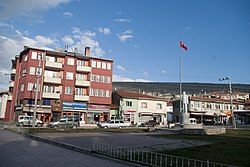Seyitgazi
Seyitgazi | |
|---|---|
 | |
 Seyitgazi | |
| Coordinates: 39°26′44″N 30°41′38″E / 39.44556°N 30.69389°ECoordinates: 39°26′44″N 30°41′38″E / 39.44556°N 30.69389°E | |
| Country | Turkey |
| Province | Eskişehir |
| Government | |
| • Mayor | Adnan Yalçın Şen (AKP) |
| • Kaymakam | Nurettin Yücel |
| Area | |
| • District | 1,516.36 km2 (585.47 sq mi) |
| Population (2012)[2] | |
| • Urban | 2,795 |
| • District | 15,192 |
| • District density | 10/km2 (26/sq mi) |
| Website | www.seyitgazi.bel.tr |
Seyitgazi is a town and district of Eskişehir Province in the Central Anatolia region of Turkey. The central town of Seyitgazi lies at a distance of 43 km (27 mi) towards the south from the province capital of Eskişehir. According to 2010 census, population of the district is 16,222 of which 2,890 live in the town of Seyitgazi.[3] The district covers an area of 1,502 km2 (580 sq mi), and the average elevation is 1,040 m (3,412 ft).
Apart from the central town of Seyitgazi, the district has two dependent townships with own municipalities. These are and Doğançayır. The district also has 46 villages.[4]
Places of interest[]
The town occupies the site of the Byzantine city of Nakoleia, and was named after the 8th-century Muslim saint (seyyid) and warrior Battal Gazi, who fell in a battle nearby in 740. A complex (Turkish: külliye) dedicated to Battal Gazi and containing his tomb, a mosque, a medrese, cells and ceremonial rooms for dervishes as well as charitable services for the community such as kitchens and a bakery was built in 1208 on a hill overlooking the town by Ümmühan Hatun, wife of the Seljuk sultan Gıyaseddin Keyhüsrev I and further extended in 1511 by the Ottoman sultan Bayezid II. The shrine and the adjoining complex remain popular with local as well as foreign visitors.
Archaeological discoveries[]
In August 2019, researchers head by Prof. Murat Türkteki announced the discovery of two skeletons dating back about 5,000 years in the same sarcophagus in Early Bronze Age settlement Küllüoba. Excavators assumed that one of the skeletons was a 13-year-old girl and other was a man in his late 30s.[5][6][7]
In August 2020, archaeologists head by Prof. Murat Türktaki revealed a 5,000-year-old paint palette made of stone in the Seyitgazi district at the Küllüoba site. According to Türktaki, this palette was used for painting dishes.[8][9]
In March 2021, discovery of the marble sarcophagus which is 1.5 meters tall and 33 centimeters wide in the Seyitgazi district at the Küllüoba site was announced by the municipal workers while construction work.[10][11][12]
Notes[]
- ^ "Area of regions (including lakes), km²". Regional Statistics Database. Turkish Statistical Institute. 2002. Retrieved 2013-03-05.
- ^ "Population of province/district centers and towns/villages by districts - 2012". Address Based Population Registration System (ABPRS) Database. Turkish Statistical Institute. Retrieved 2013-02-27.
- ^ "Seyitgazi'de Gezilecek Yerler". Türkiye'nin En Güncel Gezi ve Seyahat Sitesi, GeziPedia.net (in Turkish). Retrieved 2020-06-27.
- ^ Turkish Ministry of Culture and Tourism - Seyitgazi Archived September 29, 2007, at the Wayback Machine
- ^ sabah, daily (2019-08-04). "5,000-year-old human skeletons unearthed in central Turkey". Daily Sabah. Retrieved 2021-03-03.
- ^ "5,000-year-old double burial unearthed in central Turkey". The Archaeology News Network. Retrieved 2021-03-03.
- ^ "5,000-year-old human skeletons unearthed in central Turkey". anews. Retrieved 2021-03-03.
- ^ SABAH, DAILY (2020-08-26). "5,000-year-old paint palette unearthed in northwest Turkey". Daily Sabah. Retrieved 2021-03-03.
- ^ "5,000-year-old paint palette unearthed in northwest Turkey". The Archaeology News Network. Retrieved 2021-03-03.
- ^ AA, DAILY SABAH WITH (2021-03-01). "Construction workers discover ancient sarcophagus in NW Turkey". Daily Sabah. Retrieved 2021-03-03.
- ^ "Строители нашли загадочный древний саркофаг в Турции". www.mk.ru (in Russian). Retrieved 2021-03-03.
- ^ "Builders find mysterious ancient sarcophagus in Turkey - Around World journal". Retrieved 2021-03-03.
References[]
- . "Geographical information on Seyitgazi, Turkey". Archived from the original on 2012-10-25. Retrieved 2008-04-06.
- Governorship of Eskişehir, Turkey. "General information on Seyitgazi, Eskişehir" (in Turkish). Archived from the original on 2006-07-07. Retrieved 2008-04-06.
- Governorship of Eskişehir, Directorate of Provincial Environment and Forestry (2006). "Environmental Status Report for Eskişehir Province" (PDF) (in Turkish). Archived from the original (PDF) on 2009-03-05. Retrieved 2008-04-06.
External links[]
| Wikimedia Commons has media related to Seyitgazi. |
- District governor's official website (in Turkish)
- District municipality's official website (in Turkish)
- Map of Seyitgazi district
- Many pictures of the Battal Gazi complex and Seyitgazi village
- Seyitgazi District
- Towns in Turkey
- Eskişehir
- Populated places in Eskişehir Province
- Districts of Eskişehir Province
- Central Anatolia Region geography stubs

